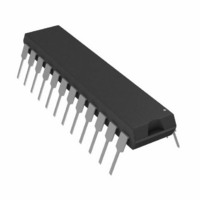AD7890BN-10 Analog Devices Inc, AD7890BN-10 Datasheet - Page 21

AD7890BN-10
Manufacturer Part Number
AD7890BN-10
Description
IC DAS 12BIT 8CH 24-DIP
Manufacturer
Analog Devices Inc
Type
Data Acquisition System (DAS)r
Datasheet
1.AD7890ARZ-10.pdf
(28 pages)
Specifications of AD7890BN-10
Mounting Type
Through Hole
Package / Case
24-DIP (0.300", 7.62mm)
Rohs Status
RoHS non-compliant
Resolution (bits)
12 b
Sampling Rate (per Second)
117k
Data Interface
Serial
Voltage Supply Source
Single Supply
Voltage - Supply
±10V
Operating Temperature
-40°C ~ 85°C
Supply Voltage
5V
No. Of Bits
12 Bit
Interface Type
Serial
Lead Free Status / RoHS Status
The serial clock rate from the 68HC11 is limited to significantly
less than the allowable input serial clock frequency with which
the AD7890 can operate. As a result, the time to read data from
the part is actually longer than the conversion time of the part.
This means that the AD7890 cannot run at its maximum
throughput rate when used with the 68HC11.
AD7890 TO ADSP-2101 INTERFACE
An interface circuit between the AD7890 and the ADSP-2101
DSP processor is shown in Figure 16. The AD7890 is
configured for its external clocking mode with the ADSP-2101
providing the serial clock and frame synchronization signals.
The RFS1 and TFS1 inputs and outputs are configured for
active low operation.
In the scheme shown, the maximum serial clock frequency the
ADSP-2101 can provide is 6.25 MHz. This allows the AD7890
to be operated at a sample rate of 111 kHz. If it is desirable to
operate the AD7890 at its maximum throughput rate of
117 kHz, an external serial clock of 10 MHz can be provided
to drive the serial clock input of both the AD7890 and the
ADSP-2101.
To monitor the conversion time on the AD7890, a scheme, such
as the scheme outlined with CONVST in the Simplifying the
Interface section, can be used. This can be implemented by
connecting the CONVST line directly to the IRQ2 input of the
ADSP-2101. An alternative to this, where the user does not have
to worry about monitoring the conversion status, is to operate
the AD7890 in its self-clocking mode. In this scheme, the actual
interface connections would remain the same as in Figure 16,
but now the AD7890 provides the serial clock and receive frame
synchronization signals. Using the AD7890 in its self-clocking
mode limits the throughput rate of the system as the serial clock
rate is limited to 2.5 MHz.
ADSP-2101
SCLK1
RFS1
TFS1
Figure 16. AD7890 to ADSP-2101 Interface
DR1
DT1
DV
DD
SMODE
RFS
TFS
SCLK
DATA OUT
DATA IN
AD7890
Rev. C | Page 21 of 28
AD7890 TO DSP56000 INTERFACE
Figure 17 shows an interface circuit between the AD7890 and
the DSP56000 DSP processor. The AD7890 is configured for its
external clocking mode. The DSP56000 is configured for
normal mode, synchronous operation with continuous clock. It
is also set up for a 16-bit word with SCK and SC2 as outputs.
The FSL bit of the DSP56000 should be set to 0.
The RFS and TFS inputs of the AD7890 are connected together
so data is transmitted to and from the AD7890 at the same time.
With the DSP56000 in synchronous mode, it provides a
common frame synchronization pulse for read and write
operations on its SC2 output. This is inverted before being
applied to the RFS and TFS inputs of the AD7890.
To monitor the conversion time on the AD7890, a scheme, such
as the scheme outlined with CONVST in the Simplifying the
Interface section, can be used. This can be implemented by
connecting the CONVST line directly to the IRQA input of the
DSP56000.
AD7890 TO TMS320C25/30 INTERFACE
Figure 18 shows an interface circuit between the AD7890 and
the TMS320C25/30 DSP processor. The AD7890 is configured
for its self-clocking mode where it provides the serial clock and
frame synchronization signals. However, the TMS320C25/30
requires a continuous serial clock. In the scheme outlined here,
the AD7890’s master clock signal, CLK IN, is used to provide
the serial clock for the processor. The AD7890 output SCLK, to
which the serial data is referenced, is a delayed version of the
CLK IN signal. The typical delay between the CLK IN and
SCLK is 20 ns and is no more than 50 ns over supplies and
temperature. Therefore, there is still sufficient setup time for
DATA OUT to be clocked into the DSP on the edges of the
CLK IN signal. When writing data to the AD7890, the
processor’s data hold time is sufficiently long to cater for the
delay between the two clocks. The AD7890’s RFS signal
connects to both the FSX and FSR inputs of the processor. The
processor can generate its own FSX signal, so if required, the
interface can be modified so that the RFS and TFS signals are
separated and the processor generates the FSX signal which is
connected to the TFS input of the AD7890.
DSP56000
SCK
SRD
SC2
STD
Figure 17. AD7890 to DSP56000 Interface
DV
DD
SMODE
RFS
TFS
SCLK
DATA OUT
DATA IN
AD7890
AD7890











